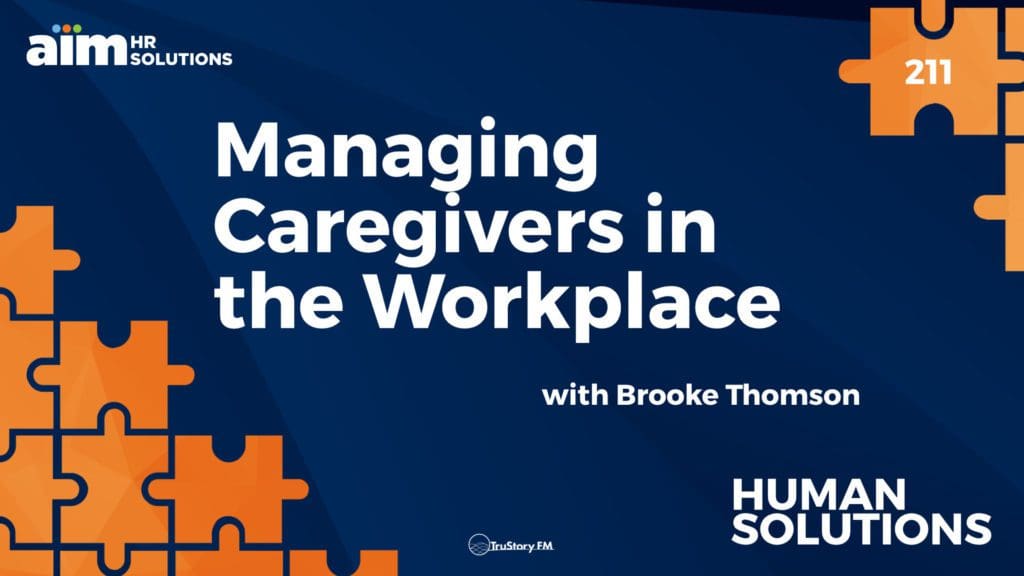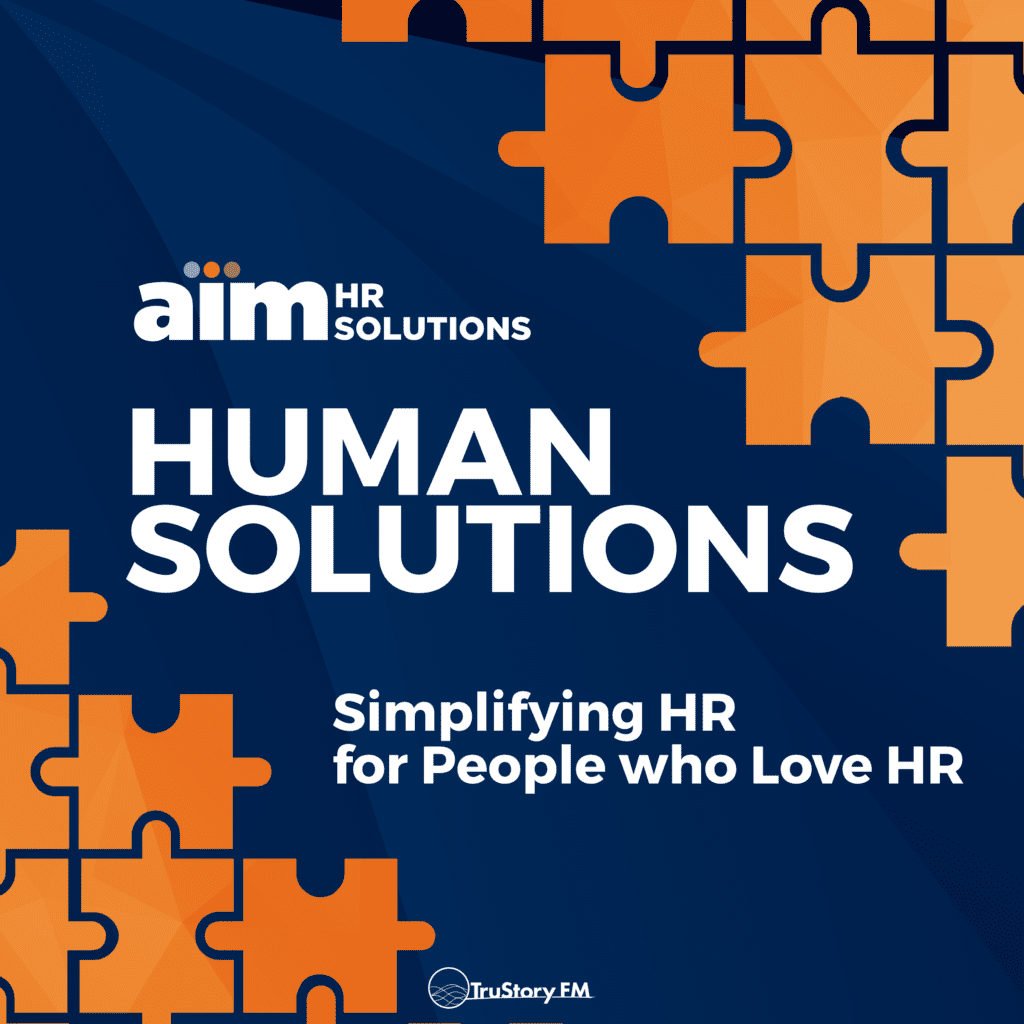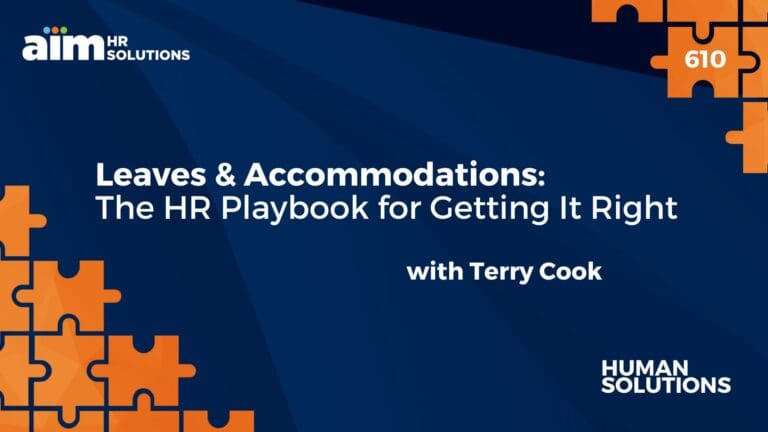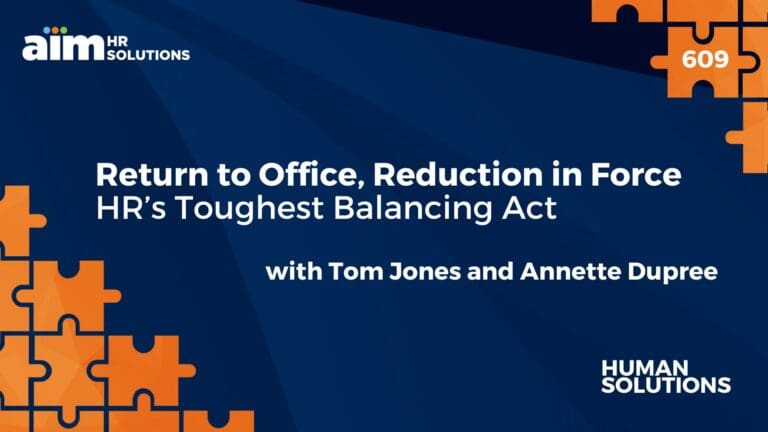The number of caregivers in the workplace has increased significantly since the onset of the pandemic. Employees have increased responsibilities for children, elderly parents, and other loved ones. Many employers provide benefits and follow business practices recommended to support employee caregivers, but creating a culture responsive to employees’ needs and well-being is as challenging as it is critical. This week, AIM EVP of Government Affairs, Brooke Thomson, joins Pete Wright to discuss employees balancing care-giving duties, and how employers are helping their employees navigate the challenge of care-giving.
Selected Recommendations from the AIM Pink Slip Initiative
- commit to providing pay increases and advancement steps to women/caregivers on schedule rather than penalizing those who have been on leave or working limited hours;
- Extend the time workers can be on leave to coincide with the duration of the pandemic;
- Give hiring preference to former workers, if their experience and skills allow, who were required to leave the workplace due to family demands;
- Extend the time that returning workers can bridge tenure for benefits and other considerations to coincide with the full duration of the pandemic;
- Listen to individual employees about their specific needs and expectations and not make assumptions about what each woman or caregiver can or cannot do;
- Institute practices that reduce conflict with remote schooling such as not holding meetings before 9 am or at lunch, when children need assistance
Other benefits that were shared during the roundtable in early November:
- Conducting employee surveys to check in
- Authentic communication from leadership on their own personal challenges
- Encouraging empathy in the workplace and providing benefits for overall well-being
- Free access to apps such as Ginger and Calm
- Employers highlighted high adoption rates for these apps
- Hosting meditation and other wellness programming
- Flexible schedules for employees, even when it impacts business operations
- Reviewing promotion data to ensure equity across workforce
- Monitoring impact of remote work on workers with caregiving responsibilities
- Access to other programming around financial planning, retirement, and other topics
- Most importantly, employers underscored the need to create a supportive culture that recognizes an employees’ overall well-being
Episode Transcript
Pete Wright:
Hello, everybody. Welcome to Human Solutions. I’m Pete Wright. The number of caregivers in the workplace has increased significantly since the pandemic. Many employees have responsibilities for children, elderly parents, and other loved ones at home. Many employers provide benefits and follow business practices recommended to support employee caregivers. Creating a culture responsive to employees’ needs and wellbeing is vital. This week, AIM EVP of Government Affairs Brooke Thompson is going to educate us all on the critical topic and how employers are helping their employees navigate the challenges of care today. Brooke Thompson, I’m so glad you are here. Welcome to the show.
Brooke Thomson:
Thank you for having me, Pete. I’m thrilled to be here.
Pete Wright:
This is a tricky conversation. It feels like a real blooming onion of cultural challenges that we’ve been dealing with over generations now. The percentage of women participating in the US labor market in October 2020, the lowest since 1988. In a year, COVID-19 has decimated so much progress in the workforce, and yet here we are, caregiving has taken on a much more complex definition at home. Can you set us up for this conversation? What do we mean when we’re talking about caregiver at home, at work in the context of 2022 America?
Brooke Thomson:
Sure. No, you hit the nail right on the head. It has never been more complex. This is an issue that we have been looking at since the pandemic began here at AIM. You pointed out correctly, right? Being a caregiver or the struggles of working plus taking care of family, whether that be minor children or aging parents, or even perhaps family members with special needs is not new. It certainly was not brought about by the pandemic, but what the pandemic did is it had this colliding of our personal lives and our work lives when we were all forced to leave the office and everything was centered at home.
On top of that, you had a real impact on the industries where typically folks would outsource, if you will, the support they needed for a lot of these caregiving roles. If you’re talking about minor children, with COVID and the fact that, again, there was just not either the workers or the families available to go to these centers, which already were understaffed and not really meeting the needs of workers. In Massachusetts, you had 60% of those programs close overnight at the height of the pandemic in March and April of 2020. Same thing for senior care facilities. Again, because this impacted everyone, including the workers who staffed those facilities, you saw those resources dwindle.
All of this came home. We were all acutely aware of it. It’s very difficult to not be acutely aware when you have children running in the background during a Zoom meeting. But then what happened is as we started to move through the phases of COVID and whatever you want to call the phase we’re in now, where we tried to go back to work or tried to have some sort of hybrid environment where the workplace changed from home to something outside the home, the needs for caregivers has not changed. We continue to have this struggle where if anything, there is a greater demand on people’s time with respect to caregiving, but less resources to support them.
What we’ve been trying to do at AIM is really talk about what roles can employers play, what policies can they implement to provide support to employees who are struggling with this?
Pete Wright:
I think that’s such a huge question that AIM is trying to be a part of the answer. I think part of it, as you say, is that I think what we got out of the pandemic is a whole class of people who didn’t even know they were caregivers until they became caregivers, because we have the traditional challenge of… Obviously we know the story of women in the workplace being culturally driven to the workplace, and yet men not being driven home at the same rate. We already knew that was miserable. I’m one of those people.
I didn’t know I was going to be a caregiver until COVID took my dad last year, and suddenly now I’m a caregiver of my parents. I didn’t see that coming. When you talk about what the pandemic did as a grand equalizer of caregiving responsibilities across families and classes and cultures, that is resonant. That is absolutely resonant. Let’s talk a little bit more about what does AIM do to contribute to that conversation.
Brooke Thomson:
Certainly. We were, as many folks were, watching the statistics, the impact at the height of the pandemic in early 2020, the impact it was having on workforce, but particularly caregivers. A lot of that was brought out just again, like I said before, by the fact kids were at home, and so parents had to find an opportunity to watch and, in some instances, even teach their minor children.
Pete Wright:
Many instances.
Brooke Thomson:
Right, right, unqualifiedly so. As a parent of two small children, I certainly am not, nor should ever be in that role again because I am in no way qualified.
Pete Wright:
Agreed.
Brooke Thomson:
We’re very cognizant here at AIM. We want to play a role that is best suited to what we can offer. Certainly as an organization that represents employers, we said, “Well, let’s collect some data on this. Let’s look at this.” Certainly we were not alone. A lot of folks have looked at the impacts of if you want to call it the She-Cession or whatever sort of came about where caregivers, and again, disproportionately they are women and people of color, started leaving the workforce. We were tracking it to try to get a sense of, well, what’s at play there and how can we maybe help bring some of these folks back as they’re juggling these caregiver roles?
And that’s where our Pink Slip Initiative was launched in early 2021. It was a play on certainly old school notions of you get a pink slip when you’re leaving the workforce. A little play on words there with pink and the disproportionate impact on women. We said, “Let’s look at this.” And not just gather the data, but then say, “Okay, based on the data, what can employers do in real time to make changes on the ground?”
We started at a very, I think, small level, like little things, saying, “Well, if you have minor children at home and they’re on their computer downstairs doing schoolwork and you have to work on your computer upstairs, let’s not schedule meetings during times when maybe you have to get them on their equipment.” And then when children went back into a physical school, again, maybe don’t schedule your meetings around the time that you would have to do drop off or pickup. And then we went and looked at other things.
Well, if we know caregivers had to perhaps leave the workplace for a little bit to take care of folks, when they want to come back, let’s not penalize them by saying, “Well, you weren’t here for 12 months or 18 months while you were caring for your mother who was sick.” Let’s go back and say, “Well, is that really fair? Given the totality of the rest of the situation, can we look and bring those folks back without penalizing them for having to take on these caregiver roles?” Through Pink Slip, we laid out a set of policies that employers could take sort of a la carte. We understand that every industry is different, right?
Certainly some industries can implement remote work, some cannot. Some industries can implement augmenting meeting times, some cannot. We tried to make a really comprehensive list of about 20 different policies employers could look at that could help encourage these folks who are in caregiving roles to still come back into the workplace.
Pete Wright:
I hope, like myself, people listening to this are thinking, how in a position of leadership and authority in an organization that is also in the middle of the pandemic and recovering from pandemic outages are sitting there thinking, “How could we possibly implement these kinds of strategies when we really need to keep the light on? We’re desperate too.” How are these policies received over the course of the period that you’re researching and presenting them?
Brooke Thomson:
I appreciate that question, Pete. We heard really positive feedback. Certainly the struggle is there and we don’t minimize it. One fantastic example of a member business who’s been very engaged in our Pink Slip Initiative and who took on implementing these types of policies was Dependable Cleaners. It’s a family owned business. Christa Haggerty, who is a fantastic female leader. It’s a family business. She took it over. Of course, as you can imagine, it’s a dry cleaning business. The majority of her workers happen to be female. They happen to be parents of small children. If she can’t physically get them into a workplace, she can’t run a business.
Now, you couple that with people weren’t going into a physical workspace, so people didn’t have a demand for dry cleaning the way it was. She was taking catastrophic hits to the bottom line while still trying to manage how she was going to keep a workforce going. She just sat back and meaningfully said, “Okay, what can I do?” She brought in resources so that if parents had to bring their kids into the workplace, they could sit in the back room, get on a computer, do remote school while they were working in the front.
She even took steps where if she couldn’t get enough staff in because they had to take care of kids or they were sick, then she would put a note on the door that says, “Today our hours are going to have to be cut short. We have to close at 5:00.” And that has real world consequences fiscally from a bottom line perspective. But when Dependable Cleaners and Christa were looking at this, she was looking at the totality of taking care of her workforce and understanding that this was a phase. But that if she did it right and really brought everybody into the fold and had conversations and tried to bring about a policy that would work, they would get past it.
Again, fabulous story, but it doesn’t work for every business and it doesn’t work for every industry. As we’ve been continuing to share these best practices, provide education and continue to collect data through the Pink Slip Initiative, we continue to try to work to see what needs are there and how we can help provide a best set of policies that will apply to different industries and different geographies. Again, if you’re on the western part of the state, your situation may be very, very different than if your physical place of work is inside Boston.
Pete Wright:
I know you have some more of these recommendations that we want to get to, because I think they’re important to make sure that we at least present them even if you and I aren’t going to litigate them directly point by point. But I do think it’s important that we get back to the question, if not now, then at some point, what the pandemic has taught us about benefits to employees that might stick. I know I might be asking you to read a little bit of a crystal ball, but I’m hearing so many cases right now of organizations across the country that are reevaluating the perks of work, of coming into work and saying, “Maybe we don’t need 15 cafeterias.”
But what has the pandemic taught us about what our employees really do need? Are some of these caregiving support resources part of that bouquet of resources that can actually make the workplace better? I present all of that to you and I ask you, how would you like to carry that forward in our final points here?
Brooke Thomson:
Sure. I think what employers have to do, I mean, we see it, the number one concern for our members, for businesses as a whole is lack of workforce right now, dealing with everything else that’s going on, whether it’s inflation or trade challenges, supply change challenges. It’s workforce, right? It’s getting qualified people in to fill positions, and inherent in that is this conversation we’re having. Again, I think the pandemic just really made employees as a whole, it added to the burdens they were facing from a caregiver perspective, and it made them reevaluate what they want from an employment perspective and what they need.
To your point, I think the number one thing all employers can do, regardless of industry or location, is listen to your employees. Sit down and have a conversation, ask how they’re feeling, what their needs are, and then again, try to be flexible. Certainly there’s no one size fits all, and I’m happy to go through just some other policies that might be something employers can consider. But I would say the number one thing is if you want to have a qualified pool of talent that wants to come and, more importantly, stay and be part of your business. Because again, employers invest a lot of time and money when they bring an employee on board.
You want to retain that talent. What you’re going to have to do is listen to your employers. I think a big part of that is this ability, we used to call it work-life balance, but what it really is is taking into consideration those demands on time and needs that the employee has at home. And making sure that the employment that they have fosters that, supports it, and makes sure that they’re in a place where they can grow and succeed.
Pete Wright:
Well, I love that you…
Brooke Thomson:
Some of the… Sorry, Pete. Go ahead.
Pete Wright:
No, I just really think this is an important nugget that you just said and I want to amplify it a little bit. I mean, it sounds like what you’re saying so much is that… I spend most of my day looking for metaphors to help me understand stuff. I love this idea of a tree. That for the last several decades, we’ve been looking at inflation, like benefits inflation. Those things are shiny and colorful leaves on a tree, but really what we’re talking about here are the foundational elements, the roots. What are your roots that are going to really help?
It might not be shiny and beautiful, but it’s really going to make an impact, and it’s going to help, as you say, the employees look at your operation and say, “I want to stay here. I want to be a part of this because they’re going to help me grow.” Let’s dig into a few more of your recommendations.
Brooke Thomson:
In addition to some of the ones that I have laid out, some other really great options that you can look at are committing to providing pay increases and advancement for women and caregivers rather than based on their work schedule. We used to have this term, and I don’t like, it’s called Mother’s Hours, one, because I think it presumes only mothers are caregivers, and it sets this group against another group mentality. But certainly we recognize that in our current world with current demands, particularly on the caregiving side, flexibility in scheduling your employees is something that’s really valuable.
Again, not every industry can do it. But I do think that if we look at it, even for industries like manufacturing, in a creative way, there is some flexibility there, and then not penalize those employees who do need that flexibility, particularly if they’re getting their job done, they’re staying, you’re retaining that talent, and then you’re continuing to build on that investment your employees have within the business itself. Again, extending to the extent you can or being flexible around the time workers can take off for sick children or caregiving parents or taking someone that they’re caring for to a doctor or a medical visit, all very important.
Looking, even to your point, Pete, about some of those longer term benefits, if we’re looking at tenure or how you’re building your longevity within a company, don’t penalize employees who may have had to take little snippets here and there to meet those caregiving roles. I would say, this goes back earlier to what I said about listening to employees, conduct regular surveys, ask them, check in regularly and see how things are going. That authentic communication at the leadership level down the chain is really, really critical.
It’s part of not just, again, making sure that you’re supporting your employees’ caregiving needs, it’s their overall emotional and mental well-being. We know just looking at data that with the pandemic and all of the demands, that mental illness and other challenges are at an all time high. I just really stress through AIM and everything we’re talking about that this is really where employers can make a meaningful difference.
Pete Wright:
You inspire a question. I feel like part of the stress and anxiety that comes with working in this period in which we live comes from the uncertainty of not knowing how the organization is going to apply these benefits. Can you talk a bit to that as a strategic initiative for organizations to help reduce stress and anxiety of the workforce?
Brooke Thomson:
Absolutely. I think, again, this comes back to communication, right? Regular honest communication with your employees about what management is thinking as it relates to schedules or benefits is important. Certainly everything is constantly changing, workforce demands. We’re struggling with certainly still COVID-19, but RSV and other illnesses that are bringing people who are immunocompromised out of school or out of assisted living and needing to be at home.
Having those regular check-ins, whether it’s quarterly if you can or more often, to see what the struggles are and then making sure that you’re communicating, “Hey, this is what we’re thinking. Maybe we haven’t made a policy change, but we want you to know we’re thinking about it. We’re soliciting feedback from you, and we will keep you posted.” On top of that, the one thing I really will stress is give employees enough lead time if you are going to change policies so that they can do what they need to do to continue to work.
If you’re going to make a policy where you’re going to bring people back into a physical workplace for a period of time and people have minor children or aging parents, they need to find alternative care if they can to meet the needs. Being cognizant of what the employee’s timelines are and needing to know that information is really, really critical. And then even little things like provide them access to the Calm app or Ginger or some of these other things where maybe you can help reduce the stress a little bit to the extent an employer can that your employees are facing day to day.
Pete Wright:
I think that’s so important, because anything else, these sudden return to work policies or you’re fired kind of policies, and that’s not an exaggeration with the kinds of headlines we’re seeing right now.
Brooke Thomson:
100%.
Pete Wright:
They just come off as you being a capricious and disconnected team of leadership. In so far as you want to reduce stress and anxiety, to your point, being clear and giving lead time is so important. You know what I’m going to do? You have such a fantastic list of these recommendations that we have documented here, and we’ve run through many of them. I’m just going to put a bulleted list in our show notes.
If you want to review some of these things that Brooke has talked about on this show and maybe some that we’ve missed, I’ll put them in the show notes. You can just scroll down through your podcast app and take a quick read. As we wrap up, Brooke, are there any specific programs in Massachusetts beyond the kinds of programs our listeners across the country might be looking forward to help support them and their caregiver efforts?
Brooke Thomson:
Sure. I would say always at a minimum, there are EAP programs available through your employer where if you’re not aware of them, you can certainly go to HR. These are programs that your employer has purchased. They are ways where they will help connect you with supportive services in the community. They’re part of your benefits package. They include things like childcare, elder care, other resources. You can go to, the website here locally is macaregivercoalition.org. They also will give you some resources.
And then I will say, something the AIM is working on for 2023 and beyond is finding ways through policy, through legislation, through working with our elected officials to give more resources and more support to a lot of these external offerings that can help particularly take some of the burden and the stress off the caregivers as we continue to try to navigate what is a very uncertain path forward.
Pete Wright:
Are there any hot buttons? The people who are listening to this show are mostly people who are in HR. When they’re looking at their own EAP programs for their employees, any hot button items you want to make sure that, that you’re looking for as an HR pro?
Brooke Thomson:
Sure. I mean, certainly look at anything related on either the elder care or childcare front where you can get resources as an employer to either connect your employees or find alternatives to bring some of that in house. I understand it doesn’t work for every employer. It’s certainly looking at your remote work, looking at flexibility of schedules, all of those things.
And then just, again, in the vein of open communication, making sure that maybe your employees saw that when they started or were onboarded a year ago, five years ago, maybe do a refresher, make them aware of it, particularly at a time like this, because it underscores the fact that employers and the folks in the HR department care and are thinking about these things and are anticipating that their employees probably are too. Again, it’s about that culture of overall well-being.
Pete Wright:
Sure. I think that’s a huge one is looking forward and backward, children and elders. Because I’m not going to lie to you, Brooke, I have had anxiety dreams where every day is bring your mother to work day and my octogenarian mother just sits on the couch behind me knitting all day long. That’s terrifying. We need to take care of them.
Brooke Thomson:
We also have this generation that’s doing it on both sides. You’re caring for your aging parents while also raising younger children. Again, the demands are higher than ever before, but I really think that, again, taking it down to a human level, having that communication, making the employees feel like they can come, they can share what they’re struggling with. Again, maybe there’s not always going to be a solution that can be done in house, but that you can work to find alternatives out there for support.
Pete Wright:
Sure, absolutely. Well, this has been a treat. Brooke, you’re fantastic. Thank you so much. I don’t know why you waited so long to come talk to me on this show, but I sure appreciate it.
Brooke Thomson:
We’ve been working on Pink Slip, but I’m happy… There you go. There you go.
Pete Wright:
That’s a fair excuse.
Brooke Thomson:
Thank you for having me, and I’d love to come back certainly as we continue in 2023 to expand what we’re trying to do in this space.
Pete Wright:
Outstanding. Well, thank you, Brooke. Thank you everybody for downloading and listening to this show. We sure appreciate your time and attention. As always, you can find links and show notes, including that bulleted list of all these wonderful recommendations as part of Pink Slip, at aimhrsolutions.com. You can listen to the show right there too or subscribe anywhere you find your favorite podcasts. Thanks, everybody. On behalf of Brooke Thompson, I’m Pete Wright, and we’ll see you next week right here on Human Solutions: Simplifying HR for People who Love HR.











